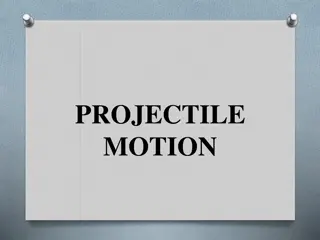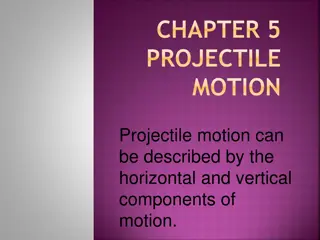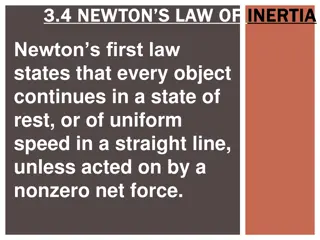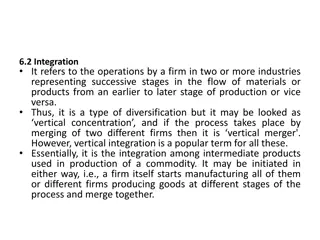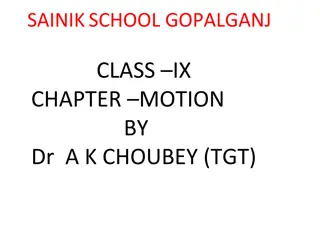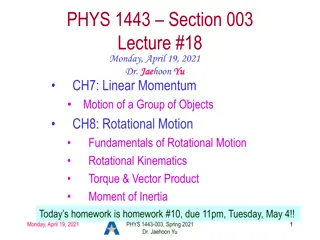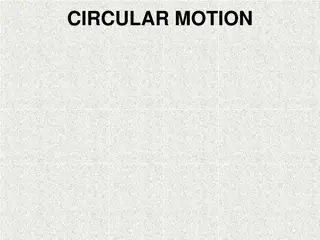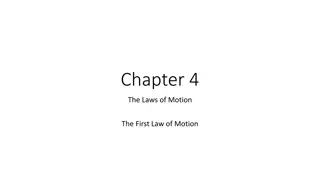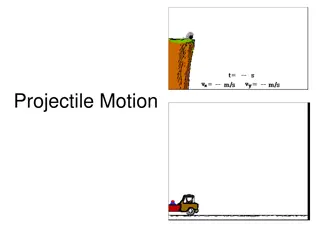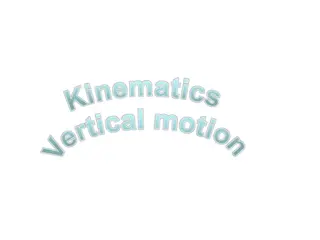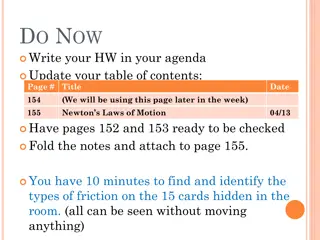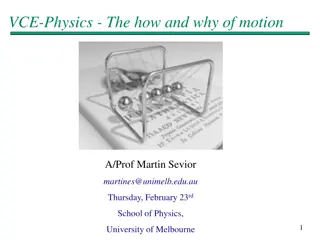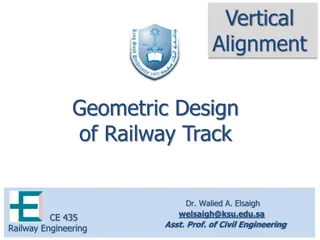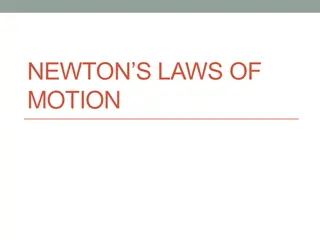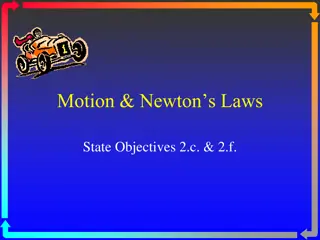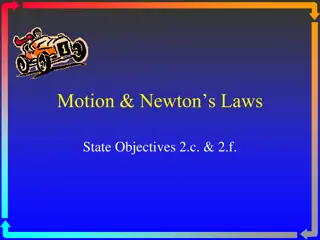
Understanding Projectile Motion in 2D Kinematics
Explore the principles of projectile motion in 2D kinematics through examples and thought experiments. Understand how horizontal and vertical components of motion affect the trajectory of a projectile. Apply concepts to solve problems involving height, duration, and impact points.
Download Presentation

Please find below an Image/Link to download the presentation.
The content on the website is provided AS IS for your information and personal use only. It may not be sold, licensed, or shared on other websites without obtaining consent from the author. If you encounter any issues during the download, it is possible that the publisher has removed the file from their server.
You are allowed to download the files provided on this website for personal or commercial use, subject to the condition that they are used lawfully. All files are the property of their respective owners.
The content on the website is provided AS IS for your information and personal use only. It may not be sold, licensed, or shared on other websites without obtaining consent from the author.
E N D
Presentation Transcript
Kinematics Projectile motion in 2D
KINEMATICS 2D KUS objectives BAT Extend the model of projectile motion to include horizontal and vertical components of motion Starter: A projectile: is an object upon which the only force acting is gravity. A ball is projected vertically from ground level at initial velocity 49 ms-1 and returns to ground level 8 seconds later. Assuming constant acceleration due to gravity: What height does the ball reach? 245 m For how long is the ball above 78.4 m ? between t=2 and t = 8 seconds makes 6 seconds
Thought experiment The cannon shoots the ball horizontally at the same time the hand drops its ball; they both hit the ground at the same time.
Imagine there was no gravity and the cannon fired the ball horizontally. The ball would continue to travel horizontally at a constant velocity (assuming no air resistance).
Components of velocity It is useful to consider the horizontal and vertical velocities of a projectile separately.
Since the only force is weight acting downwards, the horizontal motion of the ball is unaffected, it continues at a constant velocity. However, the balls vertical velocity increases.
This proves that the horizontal motion of the ball is independent of the vertical motion of the ball.
To look at this further: Open this geogebra file: projectile motion: tranquilize the monkey (ukukuku) https://www.geogebra.org/m/advVXCwe Can you explain how this example works and how it backs up the thought experiment?
WB1 A ball is kicked horizontally at 7m/s from a cliff 80m high. a) How long does it take to reach the ground? b) How far from the base of the cliff does it land? Vertically ? = ? + ?? ? + ? Horizontally ? = ? ? = +80 ??= 0 ? = ? = +9.8 ? = t ? = ? ?? = 7 ? = ? = 0 ? = 4.04 2 ? = ?? +1 ?2= ?2+ 2?? ? = ?? 1 2??2 2??2 ? = ?? +1 ? = ?? 2??2 80 = (0) +1 s = (7)(4.04) 2(9.8)?2 s = 20 2 = 28.3 ? ?2= 16.33 ? =20 2 = 4.04 ???? 7
WB2 An egg is thrown horizontally off a roof, 60m high, with initial velocity 6.5m/s. How long does it take to hit the ground? How far does it go in the horizontal direction? Vertically ? = ? + ?? ? + ? Horizontally ? = ? ? = +60 ? = 0 ? = ? = +9.8 ? = t ? = ? ? = 6.5 ? = ? = 0 ? = 3.5 2 ? = ?? +1 ?2= ?2+ 2?? ? = ?? 1 2??2 2??2 ? = ?? +1 ? = ?? 2??2 60 = (0) +1 s = (6.5)(3.5) 2(9.8)?2 s =91 4 = 22.8 ? ?2=600 49= 12.2 ? =10 6 7 = 3.5 ????
We can also look at situations where the initial velocity is NOT horizontal. ? = 20 ?? 1 40 Vertically Horizontally ?? = 20sin40 ?? = 20cos40 What can we work out with this extended model? Explore this geogebra file: https://www.geogebra.org/m/BXBMnZPS
WB3 An egg is thrown at an angle of 30 off a roof, 60m high, with initial velocity 6 m/s. How long does it take to hit the ground? How far does it go in the horizontal direction? Vertically ? = ? + ?? ? + ? Horizontally ? = ? ? = 60 ? = ?????? ? = ? = 9.8 ? = t ? = ? ? = ?????? ? = ? = 0 ? = 3.82 2 ? = ?? +1 ?2= ?2+ 2?? ? = ?? 1 2??2 2??2 ? = ?? +1 ? = ?? 2??2 60 = 6sin30 ? +1 s = (6cos30)(3.82) 2( 9.8)?2 s = 19.8 ? 4.9 ?2 3? 60 = 0 ? = ? ?2 4?? 2? ? =3 9 4(4.9)( 60) 2(4.9) = 3.82 ????
WB4 A ball is thrown from a cliff with speed 14 m/s at an angle of 35 above the horizontal. Find the position and velocity of the ball 3 seconds later. Vertically ? = ? + ?? ? + ? Horizontally ? = ? ? = ? ? = ??????? ? = ? = 9.8 ? = 3 ? = ? ? = ??????? ? = ? = 0 ? = 3 2 ? = ?? +1 ?2= ?2+ 2?? ? = ?? 1 2??2 2??2 ? = ?? +1 ? = ?? 2??2 s = 14sin35 (3) +1 s = (14cos35)(3) 2( 9.8)(9) s = 34.4 ? ? = 20.0 ? ? = ? ? = ? + ?? ? = 14sin35 + 9.8 3 = 21.4 m/s ? = 14cos35 = 11.5 ?/? Position (34.4, -20) Velocity ( 21.4)2+(11.5)2 = 24.3 m/s At an angle of arctan 21.4 11.5 = 62 below horizontal
WB5 A girl throws a stone with speed 13 m/s from a point ? at the top of a vertical cliff. The point ? is 30 m above sea level. The stone is thrown at an angle of ?, where tan? = The stone hits the sea at the point P as shown. Find: a) The distance of P from the foot of the cliff b) The speed of the stone when it hits the sea at point P 5 12 13 ?? 1 ? ? 30 ? S?? ????? ?
WB5 solution (a) a) The distance of P from the foot of the cliff Vertically ? = ? + ?? ? + ? Horizontally ? = ? ? = 30 ? = ?????? = ? ? = ? = 9.8 ? = t ? = ? ? = ?????? = ?? ? = ? = 0 ? = 3.04 2 ? = ?? +1 ?2= ?2+ 2?? ? = ?? 1 2??2 2??2 ? = ?? +1 2??2 ? = ?? 30 = ? ? +1 2( 9.8)?2 s = (?2)(3.04) 4.9 ?2 ?? 30 = 0 s = 36.4 ? ? =5 25 4(4.9)( 30) 2(4.9) = 3.04 ????
WB5 solution (b) (b) The speed of the stone when it hits the sea at point P Vertically Horizontally ? = 30 ? = ?????? = ? ? = ? = 9.8 ? = 3.04 ? = 36.4 ? = ?????? = ?? ? = ? = 0 ? = 3.04 ??= ? + ?? ??= ??= 12 ??= 5 + ( 9.8)(3.04) ??= 24.8 Combining ?? and ?? speed = ( 24.8)2+122 = 27.6
WB6 two particles A and B are simultaneously projected from point ? on a horizontal plane. The initial velocity of A is 15 m/s at an angle of 25 to the horizontal, and the initial velocity of B is 15 m/s at an angle of 65 to the horizontal a) Estimate how long B hits the ground after A b) Do they land in roughly the same place? ? ? ? Horizontal plane
WB6 solution Vertically for A Horizontally for A ? = ?? +1 ? = ?? 2??2 0 = 15sin25 ? +1 s = (15cos25)(1.29) 2( 9.8)?2 s = 17.5 ? ? =15 sin 25 = 1.29 ???? 4.9 Vertically for B Horizontally for B ? = ?? +1 ? = ?? 2??2 0 = 15sin65 ? +1 s = (15cos65)(2.77) 2( 9.8)?2 s = 17.6 ? ? =15 sin 65 = 2.77 ???? 4.9 Solution: B takes 1.48 seconds longer and lands about 10 cm further away horizontally which is roughly the same place
KUS objectives BAT Extend the model of projectile motion to include horizontal and vertical components of motion self-assess One thing learned is One thing to improve is

